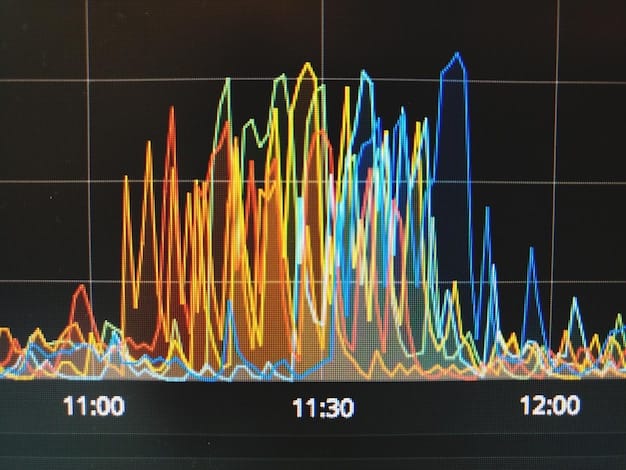The Ultimate Guide to Price Alerts: US Market Savings

Price alerts are essential tools for savvy shoppers in the US market, allowing you to track price fluctuations and snag the best deals on products you want by notifying you when prices drop to your desired level.
Want to save money while shopping in the US? The Ultimate Guide to Setting Price Alerts: Never Miss a Price Drop in the US Market shows you how to use price alerts to your advantage, ensuring you never overpay again.
Understanding Price Alerts and Their Benefits
Price alerts are notifications you receive when the price of a specific product drops to a level you’ve specified. They’re a fantastic way to monitor price changes on items you’re interested in, allowing you to buy at the optimal time and save money.
But why are price alerts so beneficial? Let’s explore some key advantages:
Saving Money
The most obvious benefit is saving money. By setting a price alert, you ensure you’re only buying when the price is right for you. This is especially useful for items that fluctuate in price frequently.
Time Efficiency
Instead of constantly checking websites for price drops, price alerts do the work for you. You get notified instantly, saving you time and effort.
- Avoid Overpaying: Never pay more than you need to for a product.
- Informed Purchase Decisions: Track price trends to make smarter buying choices.
- Discover Sales and Discounts: Be the first to know about limited-time offers.
In essence, price alerts empower you to be a more informed and efficient shopper. They provide the data you need to make smart purchase decisions.
Popular Price Tracking Tools and Websites in the US
Numerous price-tracking tools and websites are available to US consumers. Each offers a range of features to help you monitor prices and snag deals. Let’s look at some of the most popular options:
These tools can range from simple price trackers to comprehensive shopping assistants:
Google Shopping
Google Shopping provides a convenient way to track prices on various products. You can set alerts for specific items and receive notifications via email or the Google Shopping app.
CamelCamelCamel
Specifically designed for Amazon, CamelCamelCamel tracks price history and lets you set up price watches. It’s an invaluable tool for frequent Amazon shoppers.

- Honey: A browser extension that automatically searches for and applies coupon codes, and also offers price tracking features.
- Keepa: Similar to CamelCamelCamel, Keepa provides detailed price history charts and price drop alerts for Amazon products.
- Price.com: A wider view of products and prices, pulling in multiple sources to give you great options.
Choosing the right tool depends on your shopping habits and preferences. Experiment with a few to find the one that best suits your needs.
Setting Up Price Alerts: A Step-by-Step Guide
Setting up price alerts is a straightforward process. While the exact steps may vary slightly depending on the tool or website you’re using, the general principles remain the same.
Here is a step-by-step guide to get you started:
Step 1: Choose Your Tool
Select the price tracking tool or website that you prefer. Consider factors like the range of products covered, user interface, and notification options.
Step 2: Find Your Product
Search for the product you want to track. This usually involves entering the product name or URL into the search bar.
It’s essential to enter to correct item to get the most accurate results.
- Step 3: Set Your Desired Price: Enter the price you’re willing to pay for the product.
- Step 4: Configure Notifications: Choose how you want to be notified when the price drops. Options include email, push notifications, or browser alerts.
- Step 5: Activate the Alert: Confirm your settings and activate the price alert.
Once your alert is set, you can sit back and wait for the price to drop. The tool will notify you as soon as the product reaches your desired price.
Tips for Effective Price Alerting
To maximize the effectiveness of price alerts, consider these tips:
These strategies will help you get the most from price alerts by enabling more efficient tracking:
Be Specific with Your Price
Instead of setting a generic price, research the product’s price history to determine a realistic target price. Services such as CamelCamelCamel or Keepa can inform those decisions.
Monitor Price History
Pay attention to the product’s price fluctuations over time. This will help you identify patterns and predict potential price drops.

- Set Multiple Alerts: If you’re flexible with your budget, set multiple alerts at different price points to increase your chances of snagging a deal.
- Consider Sales Events: Keep an eye on major sales events like Black Friday and Cyber Monday, when prices are likely to drop significantly.
- Check Expiration Dates: Some alerts may expire after a certain period. Make sure to renew them if you’re still interested in tracking the product.
By following these tips, you can become a price alert pro and consistently save money on your purchases.
Advanced Strategies for Price Alert Users
For experienced price alert users, there are advanced strategies that can further enhance your savings.
Let’s look at some strategies for the best user:
Combine Price Alerts with Coupon Codes
Stack your savings by combining price alerts with coupon codes. Many browser extensions and websites automatically find and apply coupons, further reducing the price of your desired product.
Use Multiple Price Tracking Tools
Don’t rely on just one price tracking tool. Use multiple tools to get a more comprehensive view of the market and increase your chances of finding the best deal.
- Track Prices Across Multiple Retailers: Prices can vary significantly between retailers. Track prices on multiple websites to find the lowest price.
- Set Up Automated Alerts: Use IFTTT (If This Then That) to automate your price alerts. For example, you can set up a recipe that sends you a text message when the price of a product drops below a certain threshold.
- Consider Refurbished Items: Refurbished items are often significantly cheaper than new items. Set up price alerts for refurbished versions of the products you want to buy.
These advanced strategies require a bit more effort but can yield significant savings over time.
Common Pitfalls to Avoid When Using Price Alerts
While price alerts are a powerful tool, there are some common pitfalls to avoid.
Here’s how to sidestep mistakes:
Ignoring Price History
Relying solely on current prices without considering price history can lead to poor purchase decisions. Always research the product’s price fluctuations over time.
Setting Unrealistic Price Targets
Setting a price target that’s too low may result in missing out on good deals. Be realistic and consider the product’s average price.
- Trusting Unreliable Sources: Only use reputable price tracking tools and websites. Avoid those with a history of inaccurate information.
- Forgetting to Update Alerts: If you’re no longer interested in tracking a product, remember to deactivate the price alert.
- Missing Limited-Time Offers: Price alerts may not always capture flash sales and limited-time offers. Be proactive and check for these deals manually.
Being aware of these common pitfalls will help you use price alerts more effectively and avoid making costly mistakes.
| Key Point | Brief Description |
|---|---|
| 💰 Saving Money | Price alerts help you buy items at your desired price, saving you money. |
| ⏱️ Time Efficiency | No need to constantly check websites; alerts notify you of price drops. |
| 📈 Monitor Price History | Track price fluctuations to make informed purchase decisions. |
| 🔔 Multiple Alerts | Set multiple alerts at different price points to increase your deal chances. |
Frequently Asked Questions
▼
A price alert is a notification you receive when the price of a product drops to a specific level. You set your desired price, and the tracking tool informs you when the product meets that price. This automated tracking saves you the effort of checking prices manually.
▼
Several tools are popular in the US, including Google Shopping, CamelCamelCamel (for Amazon), Honey, Keepa, and Price.com. Each tool offers unique features, so choose one that aligns with your shopping habits and the types of products you want to track.
▼
To set a price alert on Amazon, you can use tools like CamelCamelCamel or Keepa. Simply enter the Amazon product URL into the tool, specify your desired price, and configure your notification preferences. The tool will alert you when the price drops.
▼
Yes, many price tracking tools offer mobile apps that allow you to set and manage price alerts on your smartphone. These apps send push notifications when prices drop, ensuring you never miss a deal while you’re on the go. The Google Shopping app, for example, allows this.
▼
While most reputable price tracking tools strive for accuracy, occasional discrepancies can occur. Always verify the price on the retailer’s website before making a purchase. Using multiple tools also helps cross-checking, ensuring reliability for the price you intend to pay.
Conclusion
Price alerts are a powerful tool for saving money and time while shopping in the US market. By understanding how they work, choosing the right tools, and following effective strategies, you can become a savvy shopper and never miss a price drop again.





